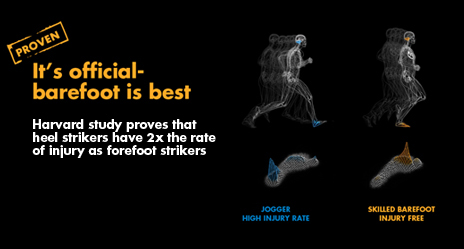It's Official: Barefoot IS Best

Yes, ladies and gentlemen, it is now official, barefoot is best. Well almost... if we do a bit of liberal interpretation 😉 . To quote Vivobarefoot's article (I've changed the link to point directly to the paper)...
Harvard Professor Daniel Lieberman has released his latest ground breaking research: "Foot Strike and Injury Rates in Endurance Runners: a retrospective study" which shows runners with a rearfoot strike have almost twice the rate of injury than those who forefoot strike, a characteristic found in skilled barefoot runners.
— IT’S OFFICIAL BAREFOOT IS BEST
Unfortunately, the paper is locked away behind a form that makes you buy it in order to read it, so I've not read the whole article yet, but the abstract gives us a good idea...
Purpose: This retrospective study tests if runners who habitually forefoot strike have different rates of injury than runners who habitually rearfoot strike. Methods: We measured the strike characteristics of middle and long distance runners from a collegiate cross country team and quantified their history of injury, including the incidence and rate of specific injuries, the severity of each injury, and the rate of mild, moderate and severe injuries per mile run. Results: Of the 52 runners studied, 36 (59%) primarily used a rearfoot strike and 16 (31%) primarily used a forefoot strike. Approximately 74% of runners experienced a moderate or severe injury each year, but those who habitually rearfoot strike had approximately twice the rate of repetitive stress injuries than individuals who habitually forefoot strike. Traumatic injury rates were not significantly different between the two groups. A generalized linear model showed that strike type, sex, race distance, and average miles per week each correlate significantly (p<0.01) with repetitive injury rates. Conclusions: Competitive cross country runners on a college team incur high injury rates, but runners who habitually rearfoot strike have significantly higher rates of repetitive stress injury than those who mostly forefoot strike. This study does not test the causal bases for this general difference. One hypothesis, which requires further research, is that the absence of a marked impact peak in the ground reaction force during a forefoot strike compared to a rearfoot strike may contribute to lower rates of injuries in habitual forefoot strikers. (C)2012The American College of Sports Medicine— Foot Strike and Injury Rates in Endurance Runners: a retrospective study
The sample size isn't very big and it doesn't conclusively prove barefoot it better than shod running - barefoot isn't even mentioned - but if they can come to their conclusion from such a small sample, we can further extrapolate to say barefoot has got to be better as you will almost certainly land on your forefoot when running barefoot. It's hurts too much not to. 😀
Now to see if I can get my hands on that paper.